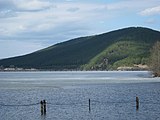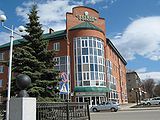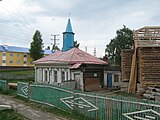Beloretsk: Difference between revisions
No edit summary |
the gallery will probably removed anyway, but two galleries, in the beginning and the end, is clearly too much |
||
| Line 2: | Line 2: | ||
'''Beloretsk''' ({{lang-ru|Белоре́цк}}; {{lang-ba|Белорет}}) is a [[types of inhabited localities in Russia|town]] and the administrative center of [[Beloretsky District]] of the [[Bashkortostan|Republic of Bashkortostan]], [[Russia]], situated on the [[Belaya (Aghidhel) River|Belaya River]], {{convert|245|km|mi|sp=us}} from [[Ufa]]. Population: 68,800 (2008 est.);{{Citation needed|date=December 2008}}; {{ru-census2002|71,093|.}} |
'''Beloretsk''' ({{lang-ru|Белоре́цк}}; {{lang-ba|Белорет}}) is a [[types of inhabited localities in Russia|town]] and the administrative center of [[Beloretsky District]] of the [[Bashkortostan|Republic of Bashkortostan]], [[Russia]], situated on the [[Belaya (Aghidhel) River|Belaya River]], {{convert|245|km|mi|sp=us}} from [[Ufa]]. Population: 68,800 (2008 est.);{{Citation needed|date=December 2008}}; {{ru-census2002|71,093|.}} |
||
| ⚫ | |||
| ⚫ | |||
| ⚫ | |||
| ⚫ | |||
| ⚫ | |||
| ⚫ | |||
| ⚫ | |||
| ⚫ | |||
| ⚫ | |||
| ⚫ | |||
| ⚫ | |||
| ⚫ | |||
| ⚫ | |||
| ⚫ | |||
==History== |
==History== |
||
| Line 72: | Line 57: | ||
==Religion== |
==Religion== |
||
{{commonscat|Beloretsk}} |
{{commonscat|Beloretsk}} |
||
| ⚫ | |||
| ⚫ | |||
| ⚫ | |||
| ⚫ | |||
| ⚫ | |||
| ⚫ | |||
| ⚫ | |||
| ⚫ | |||
| ⚫ | |||
| ⚫ | |||
| ⚫ | |||
| ⚫ | |||
| ⚫ | |||
| ⚫ | |||
<gallery widths="250"> |
<gallery widths="250"> |
||
File:Beloretsk Mosque.JPG| Beloretsk mosque |
File:Beloretsk Mosque.JPG| Beloretsk mosque |
||
| Line 77: | Line 76: | ||
File:Beloretsk Mosque2.JPG| Beloretsk mosque |
File:Beloretsk Mosque2.JPG| Beloretsk mosque |
||
</gallery> |
</gallery> |
||
==References== |
==References== |
||
Revision as of 21:19, 9 September 2011
53°58′N 58°24′E / 53.967°N 58.400°E
Beloretsk (Template:Lang-ru; Template:Lang-ba) is a town and the administrative center of Beloretsky District of the Republic of Bashkortostan, Russia, situated on the Belaya River, 245 kilometers (152 mi) from Ufa. Population: 68,800 (2008 est.);[citation needed]; 71,093 (2002 Census).[1]
History

Beloretsk was founded in 1762 as a settlement around the newly constructed Beloretsk iron factory on the Belaya(Ağidel) River.
Town-factories were a peculiar phenomenon in the town-planning in Russia in the 18th and 19th centuries. Beloretsk was founded as a factory settlement and this feature constitutes its principal cultural and historical value until now. The history of Beloretsk is closely related to the Beloretsk Iron Factory (since 1940 called Beloretsk Metallurgical Complex).
Beloretsk Iron Factory was built in 1762-1767 by merchants I. B. Tverdyshev and I. S. Myasnikov. They bought 170041 dessiatina of earth from bashkirs of Belokatay volost [2]
A Bulletin of 1776 says that The Beloretsk Iron Factory was built in 1762 and had two blast furnaces and fourteen sledge-hammers. However, the first fusion of cast iron was recorded as being done in 1767.
In 1777, Beloretsk Iron Factory produced more iron than any other factory in Russia. Productive capacity of the factory was 122,500 poods (~2,000 metric tons) of cast iron and 80,000 poods (~1,300 metric tons) of iron per year. There were 840 male workers at the factory.
The factory was built on land bought from the local people. Builders and first workers of the factory were purchased praedial serfs from Kazan, Nizhny Novgorod, Penza, and Ryazan Governorates of Russia.
The village of Lomovka was founded in the vicinity of Beloretsk. The name of the village came from the name of the profession of the people who lived there. They all were draymen who supplied raw materials for the factory. Factory peasants also lived in the village of Arskaya, situated 8 miles (13 km) from their work place.
One of the memorable events in the history of Beloretsk was the participation of the factory workers in the 1773-1774 rebellion under the leadership of Yemelyan Pugachev.
In 1774, rebel peasants took the factory by storm and reduced it to ashes to prevent recommencement work there. The villages of Lomovka and Arskaya were also burned down. The factory was inactive for three years after that.
In 1784, Beloretsk Iron Factory was inherited by D. I. Pashkova, who in 1803 started construction of the Tirlyan Iron Factory (Tirlyan was a village 30 kilometers (19 mi) away from Beloretsk).
In the beginning of the 19th century, Beloretsk Iron Factory had two blast-furnaces and eleven Catalan forges. The factory achieved much success in the production of metal. Cast iron produced by the factory was the cheapest in the South Urals and the iron produced was known for its ductility in the cold state.
In 1874, the firm "Vogau and Co." became the new owner of the factory.
In the end of the 19th century, the factory received the highest award at the Russian Countrywide Exhibition at Nizhny Novgorod.
By the end of the 19th century the population of Beloretsk was 15,000. At the time, Beloretsk was a part of Orenburg Governorate.
Factory workers were active participants of the revolutionary movement in the South Urals. In 1917, Beloretsk became a part of the Bashkir ASSR.
In July 1918, the Beloretsk Socialistic Regiment was formed consisting of the factory workers. The Regiment formed a part of the Urals Partisan Army under the command of Vasily Blyukher and performed a raid against the White Guard.
In 1923, Beloretsk was granted town status. The population of the new town, including the villages of Tirlyan and Lomovka, was 28,830. In 1930, Beloretsky District was formed. At the same time radical reconstruction of the Beloretsk Factory was started.
In 1940, Beloretsk Cast Iron Melting Factory, Beloretsk Iron Factory, Tirlyan Cast Iron Melting Factory, and Tirlyan Iron Factory were merged together under the name of Beloretsk Metallurgical Complex.
During World War II, thousands of people from Beloretsk participated in the battles against German fascist aggressors. For their courage and bravery many of them received orders and medals, thirteen of them were nominated as Heroes of the Soviet Union.
In the second half of 1941, there was a problem with the production of copper wire. The only factory that could carry out military orders was Beloretsk Copper Wire and Rope Factory. Due to the wide industrial expertise, material resources and presence of Beloretsk Iron Factory, it supplied all necessary sorts of steel, and that was most important—due to the extremely intensive hard work of thousands of half-starved local people, the factory had been successfully managing its task during World War II.
After the war, Beloretsk Iron Factory was reconstructed and extended, mechanised and automated. The factory then began to produce new kinds of products.
In 1966, Beloretsk Iron Factory was awarded the Order of the Red Banner of Labour.
In 1960s–1970s, residential and industrial construction was carried out on a substantial scale. A large number of social buildings consisting of more than 400 residential and industrial constructions were built in those decades.. On the ground floors of the many-storeyed buildings were cafes, shops, libraries, social and community centres. New schools and a hospital were also built.
In the 1990s, the transition to market economy led to the drastic recession of industry. Dozens of enterprises were closed, and hundreds of workers were laid off.
In 1996, Beloretsk Metallurgical Complex was changed to an open joint-stock company and is now known as Beloretsk Metallurgical Plant.
Religion
-
Beloretsk Metallurgical Plant in the evening
-
Beloretsk Metallurgical Plant (part)
-
Beloretsk water gateway in spring
-
Beloretsk bridge across Agidel river
-
Beloretsk pedestrian wood bridge across pond on Agidel river
-
Sberbank main building in Beloretsk
-
Beloretsk factory building
-
Вashkir gymnasium
-
Monument to liquidators of the Chernobyl disaster
-
Beloretsk homeland museum
-
Steel-maker
-
Lenin
-
Beloretsk mosque
-
Beloretsk mosque
-
Beloretsk mosque
References
- ^ Federal State Statistics Service (21 May 2004). Численность населения России, субъектов Российской Федерации в составе федеральных округов, районов, городских поселений, сельских населённых пунктов – районных центров и сельских населённых пунктов с населением 3 тысячи и более человек [Population of Russia, Its Federal Districts, Federal Subjects, Districts, Urban Localities, Rural Localities—Administrative Centers, and Rural Localities with Population of Over 3,000] (XLS). Всероссийская перепись населения 2002 года [All-Russia Population Census of 2002] (in Russian).
- ^ энциклопедический словарь Брокгауза и Ефрона















